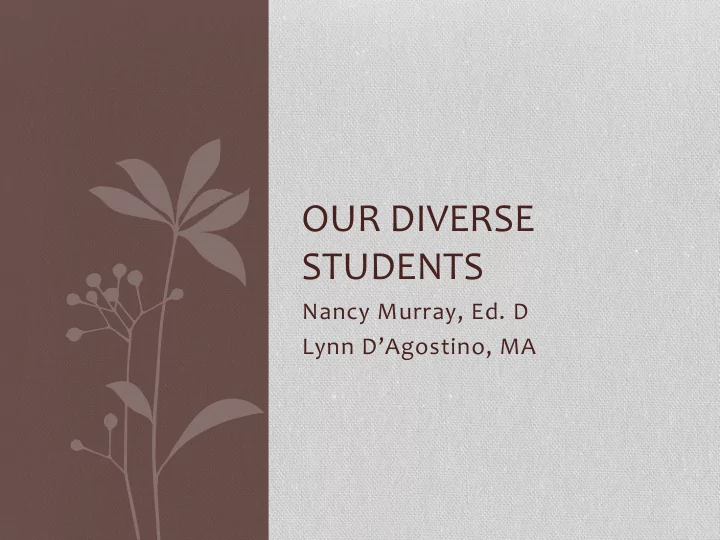

OUR DIVERSE STUDENTS Nancy Murray, Ed. D Lynn D’Agostino, MA
STUDENTS WITH AN AUTISM SPECTRUM DISORDER Nancy L. Murray
Aspects of Autism Spectrum Disorders Executive Functioning Social Theory of Mind Skills/Thinking ASD Sensory Communication Processing Obsessive Compulsive Attention Behaviors
Activity-Ready!!! • How would this impact student learning? • Attention/attending to the speaker (joint attention) • Anxiety • Organization of information and materials • Processing information
One Common Concern: • Speaking out and/or continually speaking during the class. • Meet with the student and indicate that you enjoy their participation and enthusiasm for the class, however, sometimes this minimizes opportunities for other students to share information or for you to cover the content you need to cover. • Agree upon a signal that can let the student know to hold their comment or question for a later time. If they need, they can write their comment/question down and you can touch base with them after class. • Make sure that the signal is discreet and does not embarrass the student.
What are a few things we can do? • WRITE A SCHEDULE ON THE BOARD DEPCITING THE CONTENT BEING COVERED FOR THE CLASS. • The lighting in the room- natural light is the best • Provide visual supports whenever possible to accompany content being taught. • Provide a brief visual of the directions/steps (write on board) for group/individual work during the class. • Allow students to stand during your class as long as they are attending (if you are comfortable with this). • Fidgets!
• As Lynn shares information with you about Cultural Competence, we ask that you keep in mind individuals with an Autism Spectrum Disorder as well. Their ability to understand and accurately perceive non-verbal cues is often an area of weakness. • This ability greatly impact learning.
CULTURAL COMPETENCE IN THE CLASSROOM Lynn D’Agostino TESEL Project Director
20 Questions • Form partners with someone next to you. • One person is A, the other is B. • Person A – ask B as many yes or no questions as you can in 1 minute. Person B can only say yes or no.
20 Questions • Person B – ask A as many yes or no questions as you can in 1 minute. • Person A can only say yes or no. But, you need to move your head in the opposite direction. ( nod for no, shake for yes )
20 Questions - debrief • What happened? • What did you notice about the second round? • How did you feel about using a different non- verbal method to mean yes or no? How did you feel about seeing this nonverbal communication? • What happens when nonverbal communication contradicts verbal communication?
What is culture? • a web of meaning shared by members of a particular society or group. • a shared system of beliefs, values, customs, behaviors, and artifacts that group members use to cope with their world and one another.
What is Culture?
Surface Culture • Music, visual and performing arts, drama • Holiday celebrations and folklore • Food/drink • Traditional dress • Historical contributions • Outward displays of behavior and identity
Deep Culture • Thoughts, beliefs, superstitions, religion • Concerns, hopes, fears, worries, ethics, and how you organize your thinking and world • Symbolic and intangible aspects of identity • Subtle interpersonal relationships as expressed in actions and words • Day-by-day details of life as it is lived
Cross cultural understanding
Time Management When do you show up for a party: on time? 10 minute late? 2 hours late? 5 minutes early? How about a business meeting?
Attitude towards punctuality U.S Culture Most Other Cultures
ON THE CLOCK: Views Of Time For those who live by a Living by a linear clock cyclical clock: means: • Time is limited and must • Time is unlimited; there is be used carefully and always more of it, there’s efficiently. always tomorrow. • Sticking to schedules, • Deadlines, plans, and plans and meeting schedules are considered deadlines are highly flexible. valued. • Personal needs and • Punctuality takes relationships tend to take precedence over personal precedence over needs. punctuality.
Communication Do you usually get directly to the point? Beat around the bush? Somewhere in between? Why?
Problem solving approach U.S Culture Most Other Cultures
SAY WHAT? Verbal Communications Direct Communication Indirect Communication • • Imply what you mean. Say what you mean — very little need for reading into Reading into things is the things. definitive way of communicating. • The idea of saving face is not • Saving face and of major consequence in most situations. maintaining harmony is paramount. • Silence in conversations is • Silence in conversations is viewed as uncomfortable. Interruptions are common. expected and appreciated. It is usually associated in a positive sense. Interruptions are to be avoided.
Writing Detours are Straight to the Going in circles to expected to point; concise; avoid being perceived maintain interest theme as overly assertive or and politeness expressed causing loss of face
Recommend
More recommend